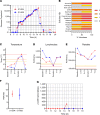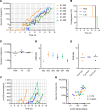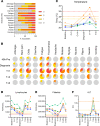Controlled human malaria infection with a clone of Plasmodium vivax with high-quality genome assembly
- PMID: 34609964
- PMCID: PMC8675201
- DOI: 10.1172/jci.insight.152465
Controlled human malaria infection with a clone of Plasmodium vivax with high-quality genome assembly
Abstract
Controlled human malaria infection (CHMI) provides a highly informative means to investigate host-pathogen interactions and enable in vivo proof-of-concept efficacy testing of new drugs and vaccines. However, unlike Plasmodium falciparum, well-characterized P. vivax parasites that are safe and suitable for use in modern CHMI models are limited. Here, 2 healthy malaria-naive United Kingdom adults with universal donor blood group were safely infected with a clone of P. vivax from Thailand by mosquito-bite CHMI. Parasitemia developed in both volunteers, and prior to treatment, each volunteer donated blood to produce a cryopreserved stabilate of infected RBCs. Following stringent safety screening, the parasite stabilate from one of these donors (PvW1) was thawed and used to inoculate 6 healthy malaria-naive United Kingdom adults by blood-stage CHMI, at 3 different dilutions. Parasitemia developed in all volunteers, who were then successfully drug treated. PvW1 parasite DNA was isolated and sequenced to produce a high-quality genome assembly by using a hybrid assembly method. We analyzed leading vaccine candidate antigens and multigene families, including the vivax interspersed repeat (VIR) genes, of which we identified 1145 in the PvW1 genome. Our genomic analysis will guide future assessment of candidate vaccines and drugs, as well as experimental medicine studies.
Trial registration: ClinicalTrials.gov NCT03797989 NCT03377296.
Keywords: Infectious disease; Malaria.
Figures






Similar articles
-
Plasmodium vivax Controlled Human Malaria Infection - Progress and Prospects.Trends Parasitol. 2017 Feb;33(2):141-150. doi: 10.1016/j.pt.2016.11.001. Epub 2016 Dec 10. Trends Parasitol. 2017. PMID: 27956060 Free PMC article. Review.
-
A randomized feasibility trial comparing four antimalarial drug regimens to induce Plasmodium falciparum gametocytemia in the controlled human malaria infection model.Elife. 2018 Feb 27;7:e31549. doi: 10.7554/eLife.31549. Elife. 2018. PMID: 29482720 Free PMC article. Clinical Trial.
-
Demonstration of the Blood-Stage Plasmodium falciparum Controlled Human Malaria Infection Model to Assess Efficacy of the P. falciparum Apical Membrane Antigen 1 Vaccine, FMP2.1/AS01.J Infect Dis. 2016 Jun 1;213(11):1743-51. doi: 10.1093/infdis/jiw039. Epub 2016 Feb 4. J Infect Dis. 2016. PMID: 26908756 Free PMC article. Clinical Trial.
-
Repeat controlled human malaria infection of healthy UK adults with blood-stage Plasmodium falciparum: Safety and parasite growth dynamics.Front Immunol. 2022 Aug 22;13:984323. doi: 10.3389/fimmu.2022.984323. eCollection 2022. Front Immunol. 2022. PMID: 36072606 Free PMC article. Clinical Trial.
-
Controlled Human Malaria Infection: Applications, Advances, and Challenges.Infect Immun. 2017 Dec 19;86(1):e00479-17. doi: 10.1128/IAI.00479-17. Print 2018 Jan. Infect Immun. 2017. PMID: 28923897 Free PMC article. Review.
Cited by
-
Preliminary characterization of Plasmodium vivax sporozoite antigens as pre-erythrocytic vaccine candidates.PLoS Negl Trop Dis. 2023 Sep 13;17(9):e0011598. doi: 10.1371/journal.pntd.0011598. eCollection 2023 Sep. PLoS Negl Trop Dis. 2023. PMID: 37703302 Free PMC article.
-
Evaluation of the precision of the Plasmodium knowlesi growth inhibition assay for Plasmodium vivax Duffy-binding protein-based malaria vaccine development.Vaccine. 2024 Jun 11;42(16):3621-3629. doi: 10.1016/j.vaccine.2024.04.073. Epub 2024 May 3. Vaccine. 2024. PMID: 38704253 Free PMC article.
-
Vaccination with Plasmodium vivax Duffy-binding protein inhibits parasite growth during controlled human malaria infection.Sci Transl Med. 2023 Jul 12;15(704):eadf1782. doi: 10.1126/scitranslmed.adf1782. Epub 2023 Jul 12. Sci Transl Med. 2023. PMID: 37437014 Free PMC article.
-
Plasmodium falciparum infection induces T cell tolerance that is associated with decreased disease severity upon re-infection.J Exp Med. 2025 Jul 7;222(7):e20241667. doi: 10.1084/jem.20241667. Epub 2025 Apr 11. J Exp Med. 2025. PMID: 40214640 Free PMC article.
-
A new Plasmodium vivax reference genome for South American isolates.BMC Genomics. 2023 Oct 11;24(1):606. doi: 10.1186/s12864-023-09707-5. BMC Genomics. 2023. PMID: 37821878 Free PMC article.
References
Publication types
MeSH terms
Associated data
Grants and funding
LinkOut - more resources
Full Text Sources
Medical
Molecular Biology Databases
Miscellaneous

